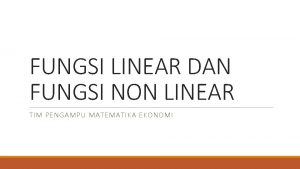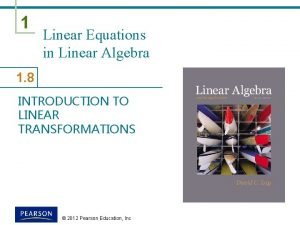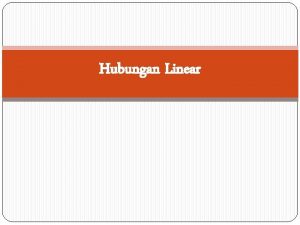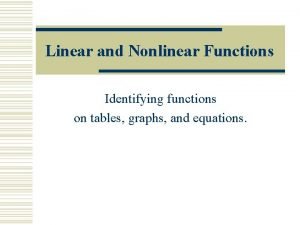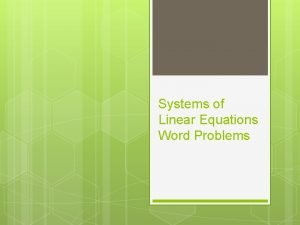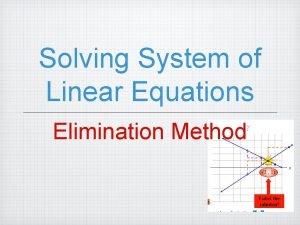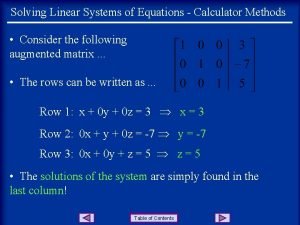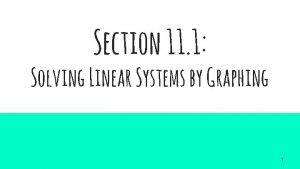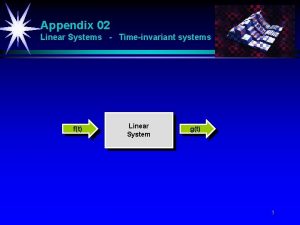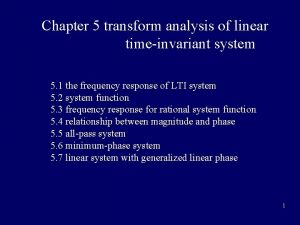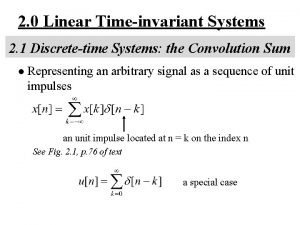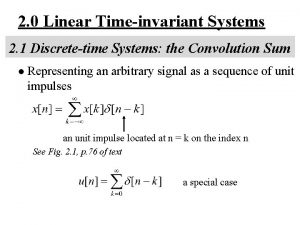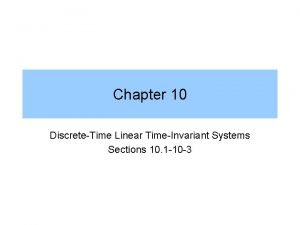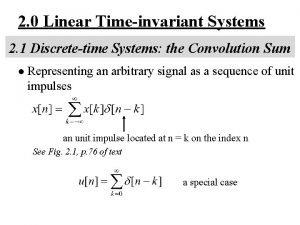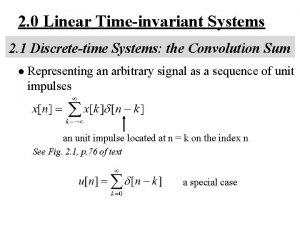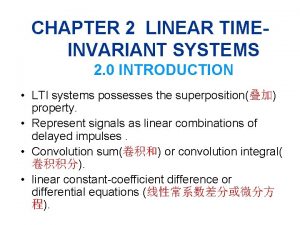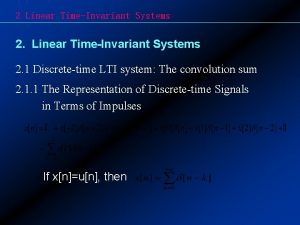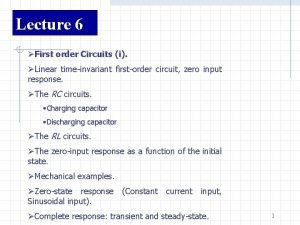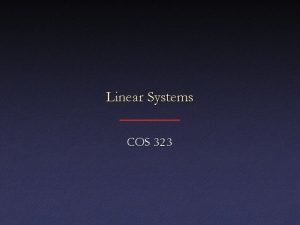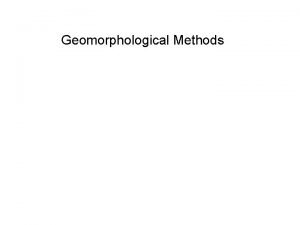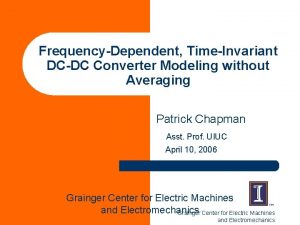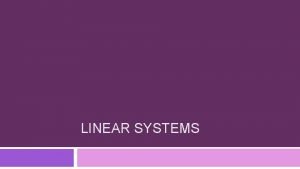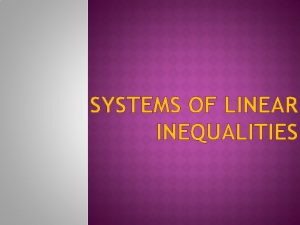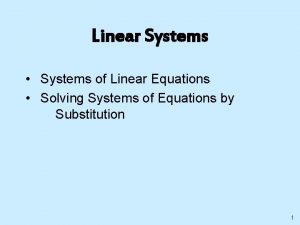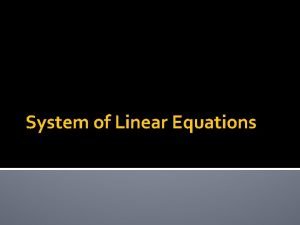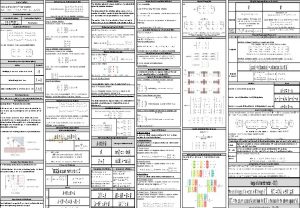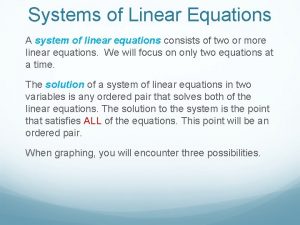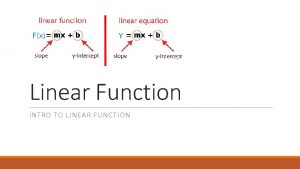Linear Systems Timeinvariant systems ft Linear System gt







![Impulse Response [1/4] Impulse Response [1/4]](https://slidetodoc.com/presentation_image/1887e032ae07723fb6c01b797ec077d3/image-8.jpg)
![Impulse Response [2/4] f(t) h(t) g(t) F( ) H( ) G( ) Impulse Response [2/4] f(t) h(t) g(t) F( ) H( ) G( )](https://slidetodoc.com/presentation_image/1887e032ae07723fb6c01b797ec077d3/image-9.jpg)
![Impulse Response [3/4] Convolution g(t) t Impulse Response [3/4] Convolution g(t) t](https://slidetodoc.com/presentation_image/1887e032ae07723fb6c01b797ec077d3/image-10.jpg)
![Impulse Response [4/4] Convolution = * Impulse Response [4/4] Convolution = *](https://slidetodoc.com/presentation_image/1887e032ae07723fb6c01b797ec077d3/image-11.jpg)


![The Impulse Function [1/2] The impulse is the identity function under convolution The Impulse Function [1/2] The impulse is the identity function under convolution](https://slidetodoc.com/presentation_image/1887e032ae07723fb6c01b797ec077d3/image-14.jpg)
![The Impulse Function [2/2] The Impulse Function [2/2]](https://slidetodoc.com/presentation_image/1887e032ae07723fb6c01b797ec077d3/image-15.jpg)
![Step Function [1/3] b b Step Function [1/3] b b](https://slidetodoc.com/presentation_image/1887e032ae07723fb6c01b797ec077d3/image-16.jpg)
![Step Function [2/3] b b Step Function [2/3] b b](https://slidetodoc.com/presentation_image/1887e032ae07723fb6c01b797ec077d3/image-17.jpg)
![Step Function [3/3] b Step Function [3/3] b](https://slidetodoc.com/presentation_image/1887e032ae07723fb6c01b797ec077d3/image-18.jpg)


![Discrete 1 -Dim Convolution [1/5] Matrix Discrete 1 -Dim Convolution [1/5] Matrix](https://slidetodoc.com/presentation_image/1887e032ae07723fb6c01b797ec077d3/image-21.jpg)
![Discrete 1 -Dim Convolution [2/5] Example Discrete 1 -Dim Convolution [2/5] Example](https://slidetodoc.com/presentation_image/1887e032ae07723fb6c01b797ec077d3/image-22.jpg)
![Discrete 1 -Dim Convolution [3/5] Discrete operation Discrete 1 -Dim Convolution [3/5] Discrete operation](https://slidetodoc.com/presentation_image/1887e032ae07723fb6c01b797ec077d3/image-23.jpg)
![Discrete 1 -Dim Convolution [4/5] Graph - Continuous / Discrete Discrete 1 -Dim Convolution [4/5] Graph - Continuous / Discrete](https://slidetodoc.com/presentation_image/1887e032ae07723fb6c01b797ec077d3/image-24.jpg)
![Discrete 1 -Dim Convolution [5/5] Wrapping h index array Discrete 1 -Dim Convolution [5/5] Wrapping h index array](https://slidetodoc.com/presentation_image/1887e032ae07723fb6c01b797ec077d3/image-25.jpg)

![Discrete Two-Dimensional Convolution [1/3] Discrete Two-Dimensional Convolution [1/3]](https://slidetodoc.com/presentation_image/1887e032ae07723fb6c01b797ec077d3/image-27.jpg)
![Discrete Two-Dimensional Convolution [2/3] Discrete Two-Dimensional Convolution [2/3]](https://slidetodoc.com/presentation_image/1887e032ae07723fb6c01b797ec077d3/image-28.jpg)
![Discrete Two-Dimensional Convolution [3/3] Kernel matrix Input image Array of products Output image Summer Discrete Two-Dimensional Convolution [3/3] Kernel matrix Input image Array of products Output image Summer](https://slidetodoc.com/presentation_image/1887e032ae07723fb6c01b797ec077d3/image-29.jpg)


- Slides: 31

Linear Systems - Time-invariant systems f(t) Linear System g(t)

Linear System A linear system is a system that has the following two properties: Homogeneity: Scaling: The two properties together are referred to as superposition.

Time-invariant System A time-invariant system is a system that has the property that the shape of the response (output) of this system does not depend on the time at which the input was applied. If the input f is delayed by some interval T, the output g will be delayed by the same amount.

Harmonic Input Function Linear time-invariant systems have a very interesting (and useful) response when the input is a harmonic. If the input to a linear time-invariant system is a harmonic of a certain frequency , then the output is also a harmonic of the same frequency that has been scaled and delayed:

Transfer Function H( ) The response of a shift-invariant linear system to a harmonic input is simply that input multiplied by a frequency-dependent complex number (the transferfunction H( )). A harmonic input always produces a harmonic output at the same frequency in a shift-invariant linear system.

Transfer Function Convolution f(t) H( ) g(t) f(t) h(t) g(t)

Convolution f(t) h(t) g(t)
![Impulse Response 14 Impulse Response [1/4]](https://slidetodoc.com/presentation_image/1887e032ae07723fb6c01b797ec077d3/image-8.jpg)
Impulse Response [1/4]
![Impulse Response 24 ft ht gt F H G Impulse Response [2/4] f(t) h(t) g(t) F( ) H( ) G( )](https://slidetodoc.com/presentation_image/1887e032ae07723fb6c01b797ec077d3/image-9.jpg)
Impulse Response [2/4] f(t) h(t) g(t) F( ) H( ) G( )
![Impulse Response 34 Convolution gt t Impulse Response [3/4] Convolution g(t) t](https://slidetodoc.com/presentation_image/1887e032ae07723fb6c01b797ec077d3/image-10.jpg)
Impulse Response [3/4] Convolution g(t) t
![Impulse Response 44 Convolution Impulse Response [4/4] Convolution = *](https://slidetodoc.com/presentation_image/1887e032ae07723fb6c01b797ec077d3/image-11.jpg)
Impulse Response [4/4] Convolution = *

Convolution Rules

Some Useful Functions A B a/2 b
![The Impulse Function 12 The impulse is the identity function under convolution The Impulse Function [1/2] The impulse is the identity function under convolution](https://slidetodoc.com/presentation_image/1887e032ae07723fb6c01b797ec077d3/image-14.jpg)
The Impulse Function [1/2] The impulse is the identity function under convolution
![The Impulse Function 22 The Impulse Function [2/2]](https://slidetodoc.com/presentation_image/1887e032ae07723fb6c01b797ec077d3/image-15.jpg)
The Impulse Function [2/2]
![Step Function 13 b b Step Function [1/3] b b](https://slidetodoc.com/presentation_image/1887e032ae07723fb6c01b797ec077d3/image-16.jpg)
Step Function [1/3] b b
![Step Function 23 b b Step Function [2/3] b b](https://slidetodoc.com/presentation_image/1887e032ae07723fb6c01b797ec077d3/image-17.jpg)
Step Function [2/3] b b
![Step Function 33 b Step Function [3/3] b](https://slidetodoc.com/presentation_image/1887e032ae07723fb6c01b797ec077d3/image-18.jpg)
Step Function [3/3] b

Smoothing a function by convolution b

Edge enhancement by convolution b
![Discrete 1 Dim Convolution 15 Matrix Discrete 1 -Dim Convolution [1/5] Matrix](https://slidetodoc.com/presentation_image/1887e032ae07723fb6c01b797ec077d3/image-21.jpg)
Discrete 1 -Dim Convolution [1/5] Matrix
![Discrete 1 Dim Convolution 25 Example Discrete 1 -Dim Convolution [2/5] Example](https://slidetodoc.com/presentation_image/1887e032ae07723fb6c01b797ec077d3/image-22.jpg)
Discrete 1 -Dim Convolution [2/5] Example
![Discrete 1 Dim Convolution 35 Discrete operation Discrete 1 -Dim Convolution [3/5] Discrete operation](https://slidetodoc.com/presentation_image/1887e032ae07723fb6c01b797ec077d3/image-23.jpg)
Discrete 1 -Dim Convolution [3/5] Discrete operation
![Discrete 1 Dim Convolution 45 Graph Continuous Discrete Discrete 1 -Dim Convolution [4/5] Graph - Continuous / Discrete](https://slidetodoc.com/presentation_image/1887e032ae07723fb6c01b797ec077d3/image-24.jpg)
Discrete 1 -Dim Convolution [4/5] Graph - Continuous / Discrete
![Discrete 1 Dim Convolution 55 Wrapping h index array Discrete 1 -Dim Convolution [5/5] Wrapping h index array](https://slidetodoc.com/presentation_image/1887e032ae07723fb6c01b797ec077d3/image-25.jpg)
Discrete 1 -Dim Convolution [5/5] Wrapping h index array

Two-Dimensional Convolution
![Discrete TwoDimensional Convolution 13 Discrete Two-Dimensional Convolution [1/3]](https://slidetodoc.com/presentation_image/1887e032ae07723fb6c01b797ec077d3/image-27.jpg)
Discrete Two-Dimensional Convolution [1/3]
![Discrete TwoDimensional Convolution 23 Discrete Two-Dimensional Convolution [2/3]](https://slidetodoc.com/presentation_image/1887e032ae07723fb6c01b797ec077d3/image-28.jpg)
Discrete Two-Dimensional Convolution [2/3]
![Discrete TwoDimensional Convolution 33 Kernel matrix Input image Array of products Output image Summer Discrete Two-Dimensional Convolution [3/3] Kernel matrix Input image Array of products Output image Summer](https://slidetodoc.com/presentation_image/1887e032ae07723fb6c01b797ec077d3/image-29.jpg)
Discrete Two-Dimensional Convolution [3/3] Kernel matrix Input image Array of products Output image Summer x. C Scaling factor Output pixel

Linear System - Fourier Transform Impulse respons Input function f(t) Spectrum of input function F( ) h(t) H( ) g(t) Output function G( ) Spectrum of output function Transfer function

End
 Is the earth a closed system
Is the earth a closed system Digestive respiratory and circulatory system
Digestive respiratory and circulatory system Simple and multiple linear regression
Simple and multiple linear regression Contoh soal metode bagi dua metode numerik
Contoh soal metode bagi dua metode numerik Linear and nonlinear text
Linear and nonlinear text What person is he
What person is he Contoh soal dan penyelesaian metode iterasi gauss -seidel
Contoh soal dan penyelesaian metode iterasi gauss -seidel Linear pipelining in computer architecture
Linear pipelining in computer architecture What is nonlinear multimedia
What is nonlinear multimedia Right linear grammar and left linear grammar
Right linear grammar and left linear grammar Contoh soal fungsi non linear
Contoh soal fungsi non linear Perbedaan fungsi linear dan non linear
Perbedaan fungsi linear dan non linear Linear independence of vectors
Linear independence of vectors Linear algebra linear transformation
Linear algebra linear transformation Koordinat lereng
Koordinat lereng Linear momentum and linear impulse
Linear momentum and linear impulse Persamaan linier simultan
Persamaan linier simultan Linear vs nonlinear graphs
Linear vs nonlinear graphs Is it linear or nonlinear
Is it linear or nonlinear Differences between linear and nonlinear equations
Differences between linear and nonlinear equations Nonlinear video editing
Nonlinear video editing Simultaneous equations linear and non linear
Simultaneous equations linear and non linear Right linear grammar to left linear grammar
Right linear grammar to left linear grammar O que é onisciente narrador
O que é onisciente narrador Solving systems of linear inequalities by graphing
Solving systems of linear inequalities by graphing Simple linear equations word problems
Simple linear equations word problems Inequalities warm up
Inequalities warm up Method of elimination
Method of elimination Solving equations calculator
Solving equations calculator Lesson 11-1 solving linear systems by graphing answer key
Lesson 11-1 solving linear systems by graphing answer key Systems of linear equations real world applications
Systems of linear equations real world applications How to solve quadratic function graph
How to solve quadratic function graph










